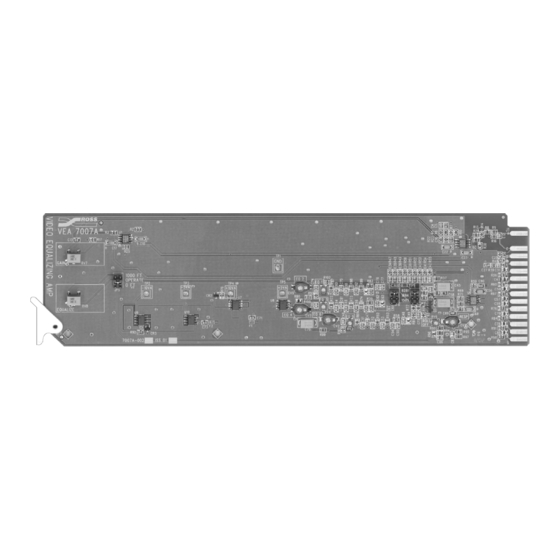
Subscribe to Our Youtube Channel
Summary of Contents for Ross VEA-7007A
- Page 1 Ross Video Limited VEA-7007A Video Equalizing Amplifier User Manual Ross Part Number: 7007AD-004 Issue: 01...
- Page 2 The information contained in this User Manual is subject to change without notice or obligation. Copyright © 2004 Ross Video Limited. All rights reserved. Contents of this publication may not be reproduced in any form without the written permission of Ross Video Limited. Reproduction or reverse engineering of copyrighted software is prohibited. Notice The material in this manual is furnished for informational use only.
-
Page 3: Important Safety Instructions
Important Regulatory and Safety Notices to Service Personnel Please review the following material to avoid injury to personnel and to prevent product damage. • All product servicing should be carried out by qualified service personnel. • This product may require specific equipment, and/or installation procedures to be carried out to satisfy certain regulatory compliance requirements. - Page 4 Changes or modifications to this equipment not expressly approved by Ross Video Ltd. could void the user’s authority to operate this equipment.
-
Page 5: Table Of Contents
In This Chapter ........................3-1 VEA-7007A Technical Specifications ..............3-2 Service Information In This Chapter ........................4-1 Troubleshooting Checklist ..................4-1 Warranty and Repair Policy ..................4-2 Ordering Information In This Chapter ........................5-1 VEA-7007A Video DA and Related Products ............5-1 Contents • i VEA-7007A User Manual (Iss. 01) - Page 6 • Contents VEA-7007A User Manual (Iss. 01)
-
Page 7: Introduction
Ross Video’s experience in engineering and design expertise since 1974. You will be pleased at how easily your new VEA-7007A fits into your overall working environment. Equally pleasing is the product quality, reliability and functionality. Thank you for joining the... -
Page 8: Overview
Temperature drift effects are almost non-existent due to the use of the latest in analog ASIC’s combined with meticulous product engineering. The VEA-7007A card is designed for use in the RossGear 7200 series video, and 7850 series A/V distribution frames. The power to each card is individually fused to prevent failure of any one card from affecting the rest of the cards in the frame. -
Page 9: Features
The following terms are used throughout this guide: • “Frame” refers to the VFR-7214, VFR-7210, AVFR-7854C, and AVFR-7855C frames that can house the VEA-7007A cards. See the respective User Manuals for details. • “Operator” and “User” both refer to the person who uses the VEA-7007A cards. - Page 10 1-4 • Introduction VEA-7007A User Manual (Iss. 01)
-
Page 11: Installation And Setup
Unpacking Unpack each VEA-7007A card you received from the shipping container, and check the contents against the packing list to ensure that all items are included. If any items are missing or damaged, contact your sales representative or Ross Video directly. -
Page 12: Cable Type Selection
Board Installation Use the following steps to install the VEA-7007A cards in a RossGear 7200 series Video, or 7850 series A/V distribution frame: 1. Refer to the User Manual of the RossGear frame to ensure that the frame is properly installed according to instructions. -
Page 13: Cable Connections
It is recommended that all unused outputs be terminated. The specifications in this manual are based on all outputs being terminated. Figure 2. VEA-7007A Cabling Designations for Rossgear 7200 and 7850 Series Frames Gain and Equalization Setup Use the following figure, card labeling, and discussions to set up gain and equalization levels with VEA-7007A potentiometers. - Page 14 2-4 • Installation and Setup VEA-7007A User Manual (Iss. 01)
-
Page 15: Specifications
Specifications In This Chapter This chapter contains the VEA-7007A Technical Specifications table. Specifications • 3-1 VEA-7007A User Manual (Iss. 01) -
Page 16: Vea-7007A Technical Specifications
±0.02dB to 10MHz (0 - 1000’) (0 - 305m) Response Accuracy Equalization – for all supported cable types typically -0.7dB @ 20MHz Power Total Consumption 2.34W Specifications are subject to change without notification. 3-2 • Specifications VEA-7007A User Manual (Iss. 01) -
Page 17: Service Information
Ross Video products distributor, or the Ross Video Technical Support department at the numbers listed under the “Contact Us” section at the end of this manual. Ross Video Ltd. is committed to providing a superior customer experience; please contact us with any questions you may have about your VEA-7007A. -
Page 18: Warranty And Repair Policy
FIVE (5) years from the date of shipment from our factory. In the event that your RossGear VEA-7007A proves to be defective in any way during this warranty period, Ross Video Limited reserves the right to repair or replace this piece of equipment with a unit of equal or superior performance characteristics. -
Page 19: Ordering Information
• FSB-7110 Frame Support Bracket (module servicing extension) Your VEA-7007A Video Equalizing Amplifier is part of the RossGear family of products. Ross Video Limited offers a full line of RossGear terminal equipment including distribution, conversion, monitoring, synchronizers, encoders, decoders, AES, keyers, control switchers, as well as analog audio and video products. -
Page 20: General Information
XML formatted set of suggested templates, to make it easier for engineers to find the technical information they need to plan a smooth project. Ross Video Limited is proud to support our broadcast industry engineers by participating in this important initiative.)














Need help?
Do you have a question about the VEA-7007A and is the answer not in the manual?
Questions and answers